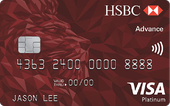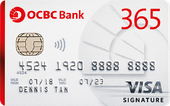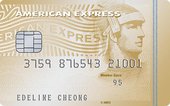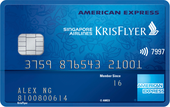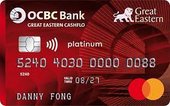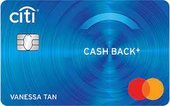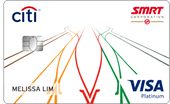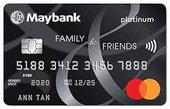What is a cashback credit card?
A cashback credit card offers a rebate on all your credit card purchases, including everyday purchases such as groceries, dining, petrol, transport and utility bills. Depending on the credit card, users can earn back a percentage of their spend, which can be higher or lower depending on the spending category. Credit cards that earn cashback allow users to save a little bit of money on every eligible purchase transaction they make.
Who are cashback credit cards suitable for?
- High spenders. If you tend to spend a lot on your credit card each month, you might as well earn cashback.
- Budget savvy shoppers. Want to stretch your dollar and save where you can? These cards help eek out more while you spend.
Who are cashback credit cards not suitable for?
- Points hackers. If you're more interested in accumulating rewards points or air miles to redeem for flights or hotel stays, a cashback card may not be a good match. That being said, if you already have a points-earning card and keep hitting its cap, you could funnel the rest of your spend through a cashback card to get value there.
- Low spenders. There may be a minimum monthly spending requirement. Failure to spend enough may mean forfeiting cashback or earning at a miserably low base rate. Considering the annual fees, this may not be very good value for money (although there are typically other perks and benefits to consider).
How cashback rebate credit cards work
Every time you make an eligible purchase with a cashback credit card, you potentially earn a cash rebate. It's not the same thing as an upfront discount. You pay the full price for your purchase, and get the cashback later. Your cashback is usually credited to your card account, so you effectively use it to pay off some or all of your account balance.
Monthly and annual cashback caps
Many cashback credit cards in Singapore have limits on how much cashback you can earn, in the form of a monthly cap (e.g. $70 in total or $25 per spending category), but there are some credit cards offering unlimited cashback.
Spending tiers unlock higher rebates
Many cashback credit cards have rebate percentages which vary depending on how much you spend in a particular period. Bigger spending earns cashback at a higher rate. For example, a cashback card may advertise 'Up to 5% cash rebate on all spend, for spend above $2,000 in each month per quarter'. What this actually means is that you must spend at least $2,000 per month in three consecutive months to earn the 5% cash rebate for the quarter. Missing the target in any single month would see you qualifying for a lower cashback percentage on all your spending.
Let's say, for example, that you spent $2,100 in Month 1 and $2,020 in Month 2, but only $1,950 in Month 3. Your whole spend amount for the quarter would miss out on the 5% rebate and would only qualify for a lower rebate, possibly a $1,000 tier which might earn cashback at 3%. And if you spent only $990 in Month 3 you might be looking at a $500 tier rebate – perhaps only 2% – on your entire quarter's spend.
But not every card has these minimum spend tiers, and a card with a flat rate rebate regardless of the amount spent might be safer for those who spend less or spend inconsistently. Flat rate rebate cards also tend to offer uncapped cashback (i.e. unlimited cashback), so they are also a good choice for really high spenders.
Spending categories
While some of the best cashback credit cards in Singapore offer either a flat or tiered rebate on all of your spend, others target specific types of spending with higher rebates.
So if you can see, for example, that most of your spend goes on dining and petrol, or on groceries, you could look for a card that rewards these areas of expenditure with a higher cashback rate.
Another cashback card might offer higher rebates for spending with specific card partners, like Grab, Best DENKI, Shell, Singapore Airlines, or NTUC FairPrice.
You could even choose to have two or more of the best cashback credit cards to target several spending categories, if you're confident that you'll remember which card to use on each occasion.
Cashback vs earning air miles or reward points
If you're looking for flexibility, rewards in the form of cashback are the most flexible. The cashback to your card account means that you are getting a discount on spending where you choose to spend.
When you earn air miles or reward points from your card, you will probably get a better return by using the rewards for their primary purpose, which is purchasing award flights with air miles or shopping online for merchandise with reward points, so you get less choice when it comes to spending your rewards than you do with cashback. Both air miles and reward points can, of course, usually be converted into cashback, but possibly at a lower rate than if you earned the cashback directly. And having to request the conversion produces just another hassle and delay.
So if you're a frequent air traveller, an air miles card may be your best choice, while those who enjoy shopping in person or online could choose a reward points card because they're happy to shop where their card tells them to (e.g. Amazon, or the bank's online rewards store). But for the best in flexibility and instant rewards (instead of having to save up heaps of points or miles), cashback credit cards come out on top.
What to compare for cashback credit cards
- Cashback rate. This determines how much cash you get back per dollar spent. The higher the better.
- Spending categories. It's common for cards to have higher cashback rates for certain categories such as groceries, dining, travel, or online shopping.
- Minimum spend requirement. There may be a requirement to spend a certain amount with the card each month. Make sure that amount aligns with your monthly spending habits.
- Caps and tiers. Some cards have unlimited cashback, but generally the amount of cashback you can earn each month is capped or tiered. These may apply for total spend or per spending category. If you're a heavy spender, be aware of what these limits are so you can optimise your spending allocation.
- Converting rewards points to cashback. While they are not principally cashback credit cards, many rewards points cards have a a redemption option which allows you to convert points into a cashback into your card account. You might want to consider this type of card as an option if you're not sure whether you want to receive cashback or some other type of reward for your spending.
- Annual fee. Unfortunately, no annual fee and cashback don't often come together. You may have to pay an annual fee of $60-$80, possibly more. The highest fees usually confer benefits like a higher cashback percentage and/or unlimited cashback.
- A sign up bonus. Some cards may offer a temporary cashback to new customers who achieve a specified spending target within the first few months of holding the card.
- Other features. Take note of whether the cashback credit card you have your eye on comes with any complimentary extras like airport lounge access or complimentary travel insurance. Small features that you can actually make good use of can make all the difference in your decision.
How to compare the best cashback credit cards
- Understand your spending habits. Start by getting a clear understanding of how much you usually spend each month and where. Refer to your existing bank and credit card statements for this.
- Identify priority spending categories. If you spend a lot on eating out or petrol, then look for cards offering high cashback rates for those categories to optimise your rewards.
- Check the minimum spend requirement. Some cards have a minimum spend requirement, some don't. If there is one, can you comfortably meet it? If not, you could forfeit your cashback that month.
- Check for caps, tiers, and limits. Many cards have a cap, tier, or some sort of limitation on how much cashback you can get. It's usually or a period, e.g. month, quarter, or year. High spenders are impacted more.
- Check for exclusions. Certain transactions are generally not eligible for cashback, but these change over time.
Alternatives to cashback credit cards
If you think that a cashback credit card is not the right choice for you, there are plenty of other options to consider:
- Rewards points credit cards. Earn points on all eligible spending and redeem them for gift cards, merchandise, travel, and – in some cases – cashback.
- Airpoints credit cards. Eligible spending earns Airpoints Dollars, which can be redeemed for free flights and upgrades, hotels and travel, rental cars and Koru Programme membership.
How to apply for a cashback credit card
The process of applying for a credit card with cashback is similar to that of applying to standard credit cards. You'll need to meet the following eligibility requirements:
- Age, and citizenship or residency. Applicants must be at least 18 years old and Singapore citizens or residents in most cases. But some types of work and student visa will make their holders eligible to apply.
- Proof of identity. For proof of identity you may be asked to provide a passport or local driver's licence.
- Income. Minimum income requirements vary between cards, rising with a higher level of benefits. To prove your income you will need to supply recent payslips and/or details of your employer.
- Credit score. Applicants will have a greater chance of approval if they can prove they're creditworthy.
